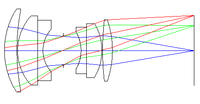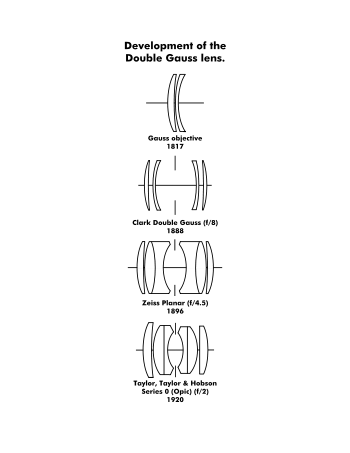- Double-Gauss lens
-
The double Gauss lens is a compound lens used mostly in camera lenses that reduces optical aberrations over a large focal plane.
Contents
Design
The double Gauss lens consists of two back-to-back Gauss lenses (a design with a positive meniscus lens on the object side and a negative meniscus lens on the image side) making two positive meniscus lenses on the outside with two negative meniscus lenses inside them. The symmetry of the system and the splitting of the optical power into many elements reduces the optical aberrations within the system. There are many variations of the design. Sometimes extra lens elements are added. The basic lens type is one of the most developed and utilized photographic lenses. The design forms the basis for many camera lenses in use today, especially the wide-aperture standard lenses used on 35 mm and other small-format cameras. It can offer good results up to f/1.4 with a wide field of view, and has sometimes been made at f/1.0. Extra wide aperture f/1.4 Double Gauss lenses usually have seven elements for extra aberration control. Modern super wide aperture models can have eight or more elements. Moderate aperture f/2.8 versions can be simplified to five elements.
The Double Gauss was likely the most intensively studied lens formula of the twentieth century,[1] producing dozens of major variants, scores of minor variants, hundreds of marketed lenses and tens of millions of unit sales.[2][3] It had almost no flaws, except for a bit of oblique spherical aberration, which could lower peripheral contrast.[4] Double Gauss/Planar tweaks were the standard wide aperture, normal and near normal prime lens for sixty years.
History
The original two element Gauss was a telescope objective lens consisting of closely spaced positive and negative menisci, invented in 1817 Carl Friedrich Gauss as an improvement to the Fraunhofer telescope objective by adding a meniscus lens to its single convex and concave lens design.[5] Alvan Clark and Bausch & Lomb further refined the design in 1888 by taking two of these lenses and placing them back to back making a "double Gauss" [6] with indifferent photographic results.[7] Current double Gauss lenses can be traced back to an 1895 improved design, when Paul Rudolph of Carl Zeiss Jena thickened the interior negative menisci and converted to them to cemented doublets of two elements of equal refraction but differing dispersion in the Zeiss Planar of 1896[8] to correct for chromatic aberration. It was the original six element symmetric f/4.5 Double Gauss lens.[9] Horace Lee added a slight asymmetry to the Planar in 1920, and created the Taylor, Taylor & Hobson Series 0 (also called the Lee Opic, UK) f/2 lens.[10] It was commercially unsuccessful, but its asymmetry is the foundation of the modern Double Gauss, including the Zeiss Biotar.[11] Later the design was developed with additional glasses to give high-performance lenses of wide aperture. The main development was due to Taylor Hobson in the 1920s, resulting in the f/2.0 Opic and later the Speed Panchro designs, which were licensed to various other manufacturers.
The Zeiss Biotar 58mm f/2 (Germany) appeared on the Ihagee Kine Exakta (1936, Germany), the first widely available 35mm single-lens reflex cameras, in 1939. It was also the standard lens on the VEB Zeiss Ikon (Dresden) Contax S (1949, East Germany), the first pentaprism eyelevel viewing 35mm SLR.[12] The Biotar, originally designed in 1927, had a six element asymmetric Double Gauss formula. Post-World War II Zeiss (Oberkochen, West Germany) no longer uses the Biotar name; instead lumping any Double Gauss variant under the Planar name.
Several contemporaneous competing, but less famous lenses, were similar to the Biotar, such as Albrecht Tronnier's Schneider Xenon (1925, Germany).[13][14] For example, three asymmetric Double Gauss lenses were produced in 1934 for Ihagee VP Exakta (1933, Germany) the type 127 roll film SLR camera: 8 cm f/2 versions of both the Biotar and Xenon, as well as the Dallmeyer Super Six 3 inch f/1.9 (UK).[15]
Early Double Gauss permutations for 35mm cameras included the Kodak Ektar 45mm f/2[16] on the Kodak Bantam Special (1936, USA), the Kodak Ektar 50mm f/1.9[17] for the Kodak Ektra (1941, USA), the Voigtländer Ultron 50mm f/2[18] on the Voigtländer Vitessa (1951, West Germany) and the Leitz Summicron 50mm f/2[19] for the Leica M3 (1953, West Germany).
During the 1960s and 70s, every optical house had Double Gauss normal lenses jockeying for sales. For example, compare the Tokyo Optical RE Auto-Topcor 5.8 cm f/1.4[20] for the Topcon RE Super/Super D (1963), Olympus G. Zuiko Auto-S 40mm f/1.4[21] for the Olympus Pen F (lens 1964, camera 1963), Yashica Auto Yashinon DX 50mm f/1.4[22] for the Yashica TL Super (1967), Canon FL 50mm f/1.4 (v2)[23][24] for the Canon FT (lens 1968, camera 1966), Asahi Optical Super Takumar 50mm f/1.4(v2) [25] for the Pentax Spotmatic (lens 1968, camera 1964), Fuji Fujinon 50mm f/1.4[26] for the Fujica ST701 (1971), Minolta MC Rokkor-PG 50mm f/1.4[27] for the Minolta XK/XM/X-1 (1973), Zeiss Planar HFT 50mm f/1.4[28] for the Rolleiflex SL350 (1974), Konishiroku Hexanon AR 50mm f/1.4[29] for the Konica Autoreflex T3 (lens 1974, camera 1973) and Nippon Kokagu Nikkor (K) 50mm f/1.4 (New)[30] for the Nikon F2 (lens 1976, camera 1971); all from Japan except Zeiss, West Germany.
Zoom lenses dominated the 1980s and 90s, and so, there were few new Double Gauss normal lenses. Zooms continue to dominate the digital era, but many new prestige low production Double Gauss lenses have appeared. Compare the Canon EF 50mm f/1.2L USM (2007, Japan),[31][32] Nikon AF-S Nikkor 50mm f/1.4G (2008, Japan/China),[33] Sigma EX DG HSM 50mm f/1.4 (2008, Japan),[34] (Cosina) Voigtländer Nokton 50mm f/1.1 (2009, Japan)[35] or Leica Noctilux-M 50mm f/0.95 ASPH (2009, Germany)[36] with their antecedents.
- History of Double Gauss lens designs
The design is presently used in inexpensive-but-high-quality fast lenses such as the Canon EF 50mm f/1.8 and Nikon 50 mm f/1.8D AF Nikkor. It is also used as the basis for faster designs, with elements added, such as a seventh element as in both Canon[37] and Nikon's 50 mm f/1.4 offerings[38] or an aspherical seventh element in Canon's 50 mm f/1.2[39]. The design appears in other applications where a simple fast normal lens is required (~53° diagonal) such as in projectors.
References
- ^ Cox, p 245.
- ^ Cox, pp 444-452.
- ^ Kingslake, pp 123-128.
- ^ Cox, pp 245-248.
- ^ Kingslake, pp 117-118.
- ^ Alvan G. Clark, Photographic Lens. United States Patent #399,499; granted 12 March 1889.
- ^ Kingslake, p 118.
- ^ Paul Rudolph, Objective Glass. United States Patent #583,336; granted 25 May 1897.
- ^ Kingslake, pp 121-122.
- ^ Kingslake, p 122.
- ^ Cox, pp 243-245.
- ^ Herbert Keppler, "Inside Straight: Optical Miracle: The amazing story of the Biotar," pp 32-33. Popular Photography & Imaging, Volume 71 Number 5; May 2007. ISSN 1542-0337.
- ^ Albrecht Wilhelm Tronnier, Photographisches Objektiv. (Photographic lens.) German Patent #DE439556; granted 30 April 1925.
- ^ Kingslake, pp 122-123.
- ^ Clément Aguila and Michel Rouah, Exakta Cameras, 1933-1978. 2003 reprint. Small Dole, West Sussex, UK: Hove Collectors Books, 1987. ISBN-10: 0-906447-38-0. pp 25-26.
- ^ Anonymous, Kodak Lenses & Shutters. (Promotional book) Rochester, NY: Eastman Kodak Co., undated, but circa 1939. p 36.
- ^ Anonymous, Kodak Ektra. (Instruction manual) Rochester, NY: Eastman Kodak Co., undated, but circa 1941. p 9.
- ^ Frank Mechelhoff, "History of fast 35mm and small format film lenses," from http://www.taunusreiter.de/Cameras/Biotar_en.html retrieved 30 April 2008.
- ^ Kingslake, p 125.
- ^ Anonymous, Beseler Topcon Super D: With Behind Mirror Meter System. (Instruction manual) no publication data, but circa 1966. p 40.
- ^ Anonymous, An Outline of Facts You Should Know About: Olympus FTography. (Dealer information guide) Los Angeles, CA: Ponder & Best, undated, but circa 1966. p 6.
- ^ Anonymous, Yashinon Lenses. (Brochure) no publication data, but circa 1974. p 13.
- ^ Anonymous, "Canon Camera Museum: Camera Hall: Lenses (FL Mount): FL50mm f/1.4II: specifications," from http://www.canon.com/camera-museum/camera/lens/fl/data/19-85/fl_50_14v2.html retrieved 7 January 2010.
- ^ Anonymous, "Canon Camera Museum: Camera Hall: Lenses (FL Mount): FL50mm f/1.4II: block diagram," from http://www.canon.com/camera-museum/camera/lens/fl/data/19-85/fl_50_14v2.html?p=2 retrieved 7 January 2010.
- ^ Anonymous, Asahi Pentax Spotmatic II Operating Manual. Tokyo, Japan: Asahi Optical Co., Ltd., September 1972. p 28.
- ^ Anonymous, "EBC FUJINON 50MM F1.4," from http://www.pentax-manuals.com/fujica/lenses/m42_50_14.htm retrieved 25 January 2010.
- ^ Anonymous, "?????????? ????? ?????????? MINOLTA MC/MD ROKKOR," (OPTICAL LENSES PATTERNS MINOLTA MC/MD ROKKOR) from http://www.rokkor-x.narod.ru/user_manuals/rokkors_schems retrieved 25 January 2010.
- ^ Frank Mechelhoff, "The Last German 35mm film cameras / Rolleiflex SL350," from http://www.taunusreiter.de/Cameras/Rolleiflex350_en.html retrieved 30 April 2008.
- ^ Andreas Buhl, "Konica SLR lenses 1960-1987: Konica Hexanon AR 50 mm / F1.4," from http://www.buhla.de/Foto/Konica/Objektive/e50_14.html retrieved 22 February 2010.
- ^ Anonymous, Nikon: Dealer Catalogue. Garden City, NY: Nikon Corp., undated, but circa 1987. p 26.
- ^ Anonymous, "Canon Camera Museum: Camera Hall: Lenses (EF Mount): EF50mm f/1.2L USM: specifications," from http://www.canon.com/camera-museum/camera/lens/ef/data/standard/ef_50_f1.2l_usm.html retrieved 4 January 2010.
- ^ Anonymous, "Canon Camera Museum: Camera Hall: Lenses (EF Mount): EF50mm f/1.2L USM: block diagram," from http://www.canon.com/camera-museum/camera/lens/ef/data/standard/ef_50_f1.2l_usm.html?p=2 retrieved 4 January 2010.
- ^ Anonymous, "AF-S NIKKOR 50mm f/1.4G," from http://imaging.nikon.com/products/imaging/lineup/lens/af/normal/af_50mmf_14g/index.htm retrieved 4 January 2010.
- ^ Anonymous, SIGMA: Lens Catalogue. Kawasaki, Kanagawa, Japan: Sigma Corp., June 2008. p 15.
- ^ Anonymous, "L&VM standard- Lens," from http://www.cosina.co.jp/seihin/voigt/english/standard-e.html retrieved 4 January 2010.
- ^ Anonymous, LEICA NOCTILUX-M 50 mm f/0.95 ASPH. (Brochure) Solms, Germany: Leica Camera AG, 2009. p 1.
- ^ EF50mm f/1.4 USM
- ^ AF Nikkor 50mm f/1.4D
- ^ EF50mm f/1.2L USM
External links
Categories:- Photographic lenses
- Photographic lens designs
Wikimedia Foundation. 2010.






